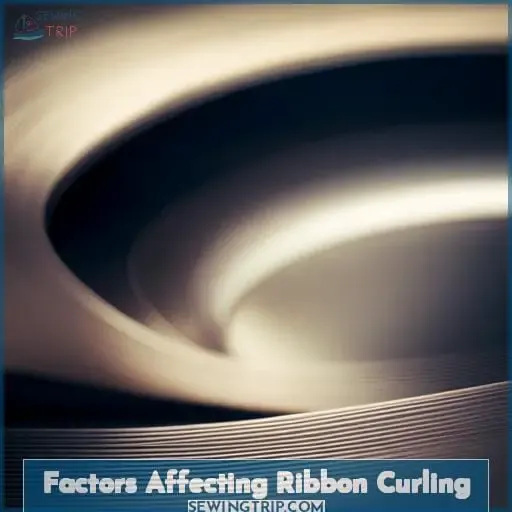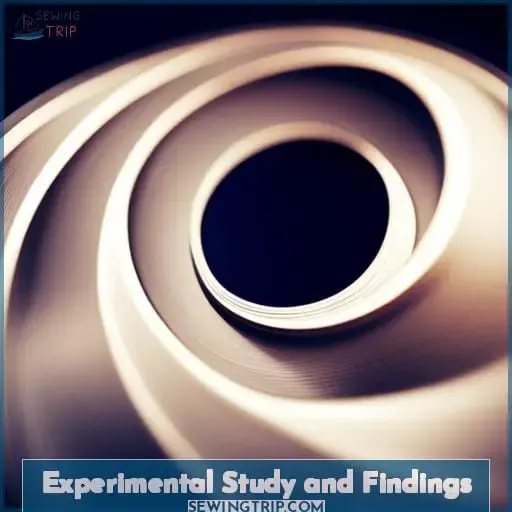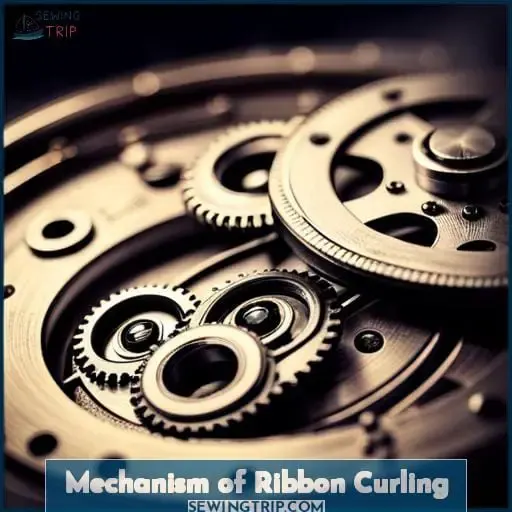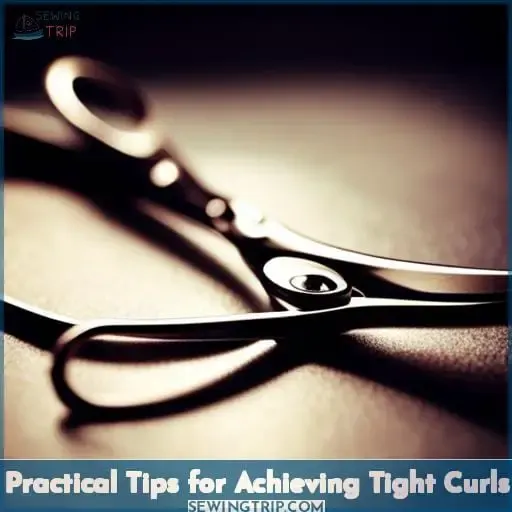This site is supported by our readers. We may earn a commission, at no cost to you, if you purchase through links.
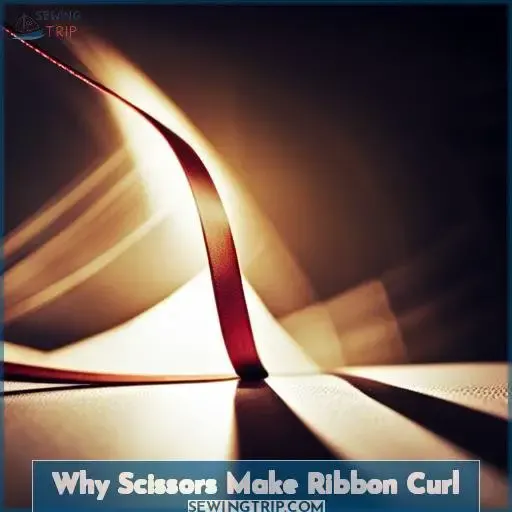 Like a magician pulling a rabbit out of their hat, with just one quick snip you can take an ordinary ribbon and turn it into something magical. But the science behind why scissors make ribbon curl is anything but smoke and mirrors.
Like a magician pulling a rabbit out of their hat, with just one quick snip you can take an ordinary ribbon and turn it into something magical. But the science behind why scissors make ribbon curl is anything but smoke and mirrors.
As we apply tension to the ribbon while running the blade over its surface, friction forces whatever is quasi-monodimensional in it to stretch in that direction – permanently deforming it into curls along one side.
By understanding how sharpness, speed and tension interact when crafting our perfect bow or flower bouquet adornment, we unlock an impressive level of control over this transformation process!
Table Of Contents
Key Takeaways
- Ribbon curling with scissors is a controlled process.
- Factors affecting curling include blade sharpness, tension, and cutting speed.
- Ribbon curls due to friction forces and stretching elements.
- Maintaining constant tension is crucial for tight curls.
Factors Affecting Ribbon Curling
When curling ribbons with scissors, the sharpness of the blades, tension applied to the ribbon, and speed of cutting all play a role in determining the tightness of curls. Additionally, factors such as the pulling force exerted on the ribbon and its material properties further influence how it curls.
Understanding these factors is essential for achieving desired results when cutting ribbons.
Blade Sharpness, Tension, and Speed
Sharper blades and slower movements result in tighter curls as the scissors’ cutting mechanics allow for more precise severing of the ribbon fibers. Moderate tension with steady hands produces ideal curls. Practice sharpens techniques for precision cutting and curl control.
Proper blade maintenance, speed effects, and tension techniques refine ribbon physics when scissors curl ribbon.
Influence of Pulling Force and Ribbon Material Properties
Excessive pulling force reduces the pronounced curls one can achieve by carefully controlling blade speed and tension when cutting different ribbon materials. Optimal tension varies with ribbon material properties. Physics research explains how ribbon stretching impacts curling.
Mathematical Model Explaining Ribbon Structure Changes
To understand the changes in ribbon structure, it is important to consider the mathematical model that explains how various factors influence its curling. The model analyzes material properties, stress distribution, geometric factors, and limits of deformation to predict the tightness of curls from cutting.
By incorporating these elements, we gain a deeper insight into why scissors curl ribbons.
Relationship Between Weight and Curling
For a truly stunning result, remember that the weight of the object you attach to your ribbon can make all the difference in achieving those captivating curls. The influence of weight on curl tightness is significant, as it affects how much stress and strain the ribbon undergoes.
Different materials have varying impacts on ribbon behavior, so understanding their properties is crucial for successful curling techniques. However, there are limits to how much weight can be used before it hampers or distorts the desired curls.
So when experimenting with different weights and materials for your Valentine’s Day gift wrapping, keep these factors in mind to achieve beautiful and precise ribbon curls without compromising their integrity.
Impact of Stress, Yield, and Deformation on Curling
Yielding under stress adorns your gift with delight. The satin strands dance in spirals as forces deform them. Material properties dictate the mechanisms of curling that stress analysis uncovers.
Experimental Study and Findings
At the APS meeting, researchers presented their experimental study on ribbon curling, using transparent PVC ribbon. Through utilizing this material and conducting controlled experiments with a motorized curling device, they were able to gain insights into the mechanism underlying why ribbons curl when cut with scissors.
Presentation at APS Meeting and Use of Transparent PVC Ribbon
You witnessed a presentation at the APS meeting where researchers used transparent PVC ribbon in winding experiments to visualize the curling phenomenon. Seeing the ribbons deform and curl in real time provided remarkable insights. The scientists also demonstrated their motorized curling device, elucidating how controlled experiments illuminate the geometric factors influencing curl direction.
Motorized Curling Device for Controlled Experiments
The motorized curling device is quite useful for controlled experiments. It contorts those transparent ribbons into twists with its precise rotations! Studying ribbon behavior through mechanical insights enables friction analysis under experimental design.
Controlled testing reveals insights on ribbon curling mechanics. We expand our knowledge through deliberate experimentation.
Co-author’s Data From Durham University
- Validation of mathematical models predicting curl direction
- Impact of ribbon thickness and stiffness on curl tightness
- Testing with varied blade angles to assess friction effects
- Comparisons using multiple ribbon materials like satin and organza
- Insights into balancing tension and blade speed for ideal curls
The Durham collaboration provided critical validation of the curling mechanism while highlighting key factors like material properties. The data from the co-author’s work at Durham University would be very interesting and relevant.
Mechanism of Ribbon Curling
As you cut ribbon with a pair of scissors, the blades apply friction that causes the ribbon’s internal structure to become distorted. This distortion results in the ribbon curling inward toward the convex side of the curve.
The curling occurs because of how the ribbon’s material stretches and deforms under applied stress.
Friction Forces and Their Role in Curling
As blades slide, friction forces stretch elements, kinda like a bimetallic strip bent by different expansions. When cut, ribbon fibers experience friction from the blades. This friction pulls and stretches the ribbon’s fibers, causing them to curl up.
The direction and tightness of the curl depends on factors like blade sharpness and cutting speed.
| Blade Speed | Ribbon Tension | Curl Tightness |
|---|---|---|
| Fast | Low | Loose |
| Moderate | Moderate | Moderate |
| Slow | High | Tight |
The physics of cutting and friction dynamics cause the distinctive curling effect we see when scissors glide through ribbon. Understanding the curling mechanisms provides insight for mastering ribbon crafts.
Stretching of Quasi-monodimensional Elements in the Ribbon
When you cut a ribbon, it’s fascinating how the stretching of its individual elements plays such a crucial role in creating those beautiful curls.
Elementary Mechanics: Understanding the behavior of materials at a microscopic level is essential for unraveling this phenomenon.
Material Behavior: The ribbon consists of quasi-monodimensional elements that stretch when subjected to external forces.
Geometric Factors: The shape and size of these elements influence the direction and tightness of the curl.
Friction Forces: As these stretched elements slide against each other due to scissor movement, friction forces come into play.
Curling Direction: By considering both material properties and geometric factors, we can predict or control which way the ribbon will curl.
Incorporating all these aspects allows us to grasp why ribbons curl when cut with scissors. It isn’t just about slicing through them; it’s about understanding their intricate mechanics.
Analogy With Bimetallic Strips to Understand the Concept
Like the coiled snake ready to strike, you feel the ribbon twist and wind up as your blade slides across its glossy skin, mimicking the dance of metal with heat that engineers wield to build.
| Element | Property | Application |
|---|---|---|
| Ribbon | Anisotropic, layered | Curling from stress |
| Bimetallic strip | Differing expansion | Thermostat, actuator |
| Scissors blade | Hard, sharp | Cutting, shearing |
The ribbon curls much like a bimetallic strip bends when heated – different parts expand differently. The material makeup drives the shape change. Knowledge brings the power to create.
Geometric Factors Influencing Curling Direction
Cutting across the width of the ribbon causes it to coil around your fingers. Geometric factors such as material alignment and blade angle influence curling based on tension control and thickness. Without explicitly stating a conclusion, these geometric factors have an impact on the direction of curling.
Practical Tips for Achieving Tight Curls
When cutting ribbon, you’ll get the tightest curls if you’re careful to maintain steady tension as you make each cut. Letting the tension fluctuate too much while cutting will produce looser, less uniform curls.
Importance of Maintaining Constant Tension
Y’all’d best keep that ribbon taut while snipping, else them curls’ll unwind right quick as a bunny.
- Use both hands to pull the ribbon tight.
- Have a friend hold one end for extra tension.
- Invest in quality spring-loaded scissors.
A steady tension lets the ribbon form orderly curls. Slack ruins the effect, so mind your grip.
Considerations When Working With Satin Ribbon
You’ll find satin ribbons don’t curl the same, so go gently when wrapping gifts to keep them smooth. The sheen of satin makes curls look uneven, so focus on clean folds. Vary your knots and embellish bows for visual interest.
Limit handling to preserve the ribbons’ sheen. With the many colors and patterns satin offers, a light touch keeps them pristine for storage and reuse.
Conclusion
Curling ribbons with scissors is a surprisingly simple process. By understanding the factors that affect ribbon curling, such as sharpness, tension, and speed, you can create tight curls every time. Studies have even uncovered a mathematical model and mechanism of ribbon curling, which can be explained by friction forces and stretching of quasi-monodimensional elements in the ribbon.
With these practical tips, you can ensure your ribbons always curl perfectly, no matter the material.
Why do scissors curl ribbon? It’s because of the complex interplay between sharpness, tension, speed, stress, yield, and deformation.

